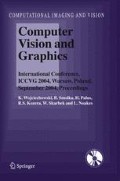Abstract
This article describes a new calibration technique to determine the position and orientation of linescan cameras. The novelty of the method lies in the determination of the camera projection plane with no restriction on its world position. Using scanning properties and a special calibration pattern the external camera parameters are computed. An evaluation of the method accuracy is given by the minimum distance between the computed back projected ray and a 3D reference point.
Access this chapter
Tax calculation will be finalised at checkout
Purchases are for personal use only
Preview
Unable to display preview. Download preview PDF.
REFERENCES
Caprille B., Torre V. (1990). Using vanishing points for camera calibration. International Journal of Computer Vision, 4:127–140.
Faugeras O., Quan L., Sturm P. (1998). Self-calibration of a 1d projective camera and its application to the self-calibration of a 2d projective camera. Technical report.
Greer, C. (2001). Fundamentals of machine-vision cameras (part 1). 2.
Gupta R., Hartley R. I. (1997). Linear pushbroom cameras. IEEE Transaction of Pattern Analysis and Machine Intelligence, 9:963–975.
Kim T., Shin D., Lee Y.-R. (2001). Development of a robust algorithm for transformation of a 3d object point onto a 2d image point for linear pushbroom imagery. Photogrammetric Engineering and Remote Sensing, 67(4):449–452.
Press W. H., Teukolsky S. A. (1999). Numerical Recipes in C (2nd ed.): the art of scientific computing.
Schmidt R., Schramm U., Hofman R.-Caulier Y. Spinnler K. Wittenberg T. (2000). Automatic three-dimensional inspection, measurement and detection of errors in transparent pipes; computer graphics forum. Vision, Modelling, and Visualization, Saarbruecken, pages 19–24.
Tsai, R. Y (1997). A versatile camera calibration technique for high accuracy 3d machine vision metrology using off-the-shelf tv cameras and lens. IEEE Journal of Robotics and Automation, (03):323–344.
Author information
Authors and Affiliations
Editor information
Editors and Affiliations
Rights and permissions
Copyright information
© 2006 Springer
About this chapter
Cite this chapter
Caulier, Y., Spinnler, K. (2006). RECONSTRUCTION ACCURACY WITH ID SENSORS. In: Wojciechowski, K., Smolka, B., Palus, H., Kozera, R., Skarbek, W., Noakes, L. (eds) Computer Vision and Graphics. Computational Imaging and Vision, vol 32. Springer, Dordrecht. https://doi.org/10.1007/1-4020-4179-9_4
Download citation
DOI: https://doi.org/10.1007/1-4020-4179-9_4
Publisher Name: Springer, Dordrecht
Print ISBN: 978-1-4020-4178-5
Online ISBN: 978-1-4020-4179-2
eBook Packages: Computer ScienceComputer Science (R0)

